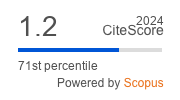Impact of blended learning on studying English as a Foreign Language
DOI:
https://doi.org/10.29038/eejpl.2023.10.1.holKeywords:
blended learning, online form, F2F, distant learning, off-line, EFL course, Likert scaleAbstract
The paper focuses on the research of the efficiency of three primary forms of teaching and besides, blended learning influence on learning and teaching English as a foreign language at Yuriy Fedkovych Chernivtsi National University, Ukraine, at Faculties of Economics (particularly, Economic Cybernetics), Law, Pedagogy and Psychology, Philology, for two academic years 2020/2021, 2021/2022. The study sample consisted of 120 students from 4 mentioned faculties who took the compulsory academic discipline English for Specific Purposes in the 1st, 2nd and 3rd semesters in compliance with their curriculum. The objectives of the study are to analyze and compare the effectiveness of the practical application of the three primary forms of education (full-time, distant and blended) and to study the impact of blended learning on teaching and learning English as a foreign language in practical classes of the compulsory English course. For the research, a questionnaire survey divided into two parts was used. Each of the survey parts included four items. The second part of the survey was conducted based on the typical 5-level Likert scale. To analyze the elicited data, SPSS (Statistical Package for the Social Sciences) program was used for the qualitative research. The outcomes in both parts are presented in percentages. The study conclusions showed that a blended study is the challenge of the present-day education system and is highly approved by university students. They are sure that using blended learning in teaching EFL at Chernivtsi National University is beneficial, advantageous and productive for improving skills in English as a foreign language course. Four-fifths of the respondents stated that their language proficiency skills significantly enhanced compared to conventional teaching methods.
Author: Nataliia Holovatska
Downloads
References
Akkoyunlu, B., & Soylu, M.Y. (2008). A study of student’s perceptions in a blended learning environment based on different learning styles. Educational Technology & Society, 11(1), 183-193.
Allen, I. E., Seaman, J., & Garrett, R. (2007). Blending in: The extent and Promise of Blended Education in the United States. Sloan Consortium. Retrieved from http://sloanconsortium.org.
Blake, R.J. (2011). Current trends in online language learning. Annual Review of Applied Linguistics, 31, 19-35. https://doi.org/10.1017/S026719051100002X
Bock, A., Modabber, A., Kniha, K., Lemos, M., Rafai, N., & Hölzle, F. (2018). Blended Learning Modules for Lectures on Oral and Maxillofacial Surgery. British Journal of Oral and Maxillofacial Surgery, 56(10), 956-961. https://doi.org/10.1016/j.bjoms.2018.10.281.
Boelens, R., Voet, M., & De Wever, B. (2018). The design of Blended Learning in Response to Student Diversity in Higher Education: Instructors’ Views and Use of Differentiated Instruction in Blended Learning. Computers & Education, 120, 197-212. https://doi.org/10.1016/j.compedu.2018.02.009
Drysdale, J.S., Graham, C. R, Spring, K.J., & Halverson, L.R., (2013). An analysis of research trends in dissertations and theses studying blended learning. Internet and Higher Education, 17, 90-100. https://doi.org/10.1016/j.iheduc.2012.11.003
Fryer, L. K., Bovee, H. N. Nakao, K. (2014). E-learning: Reasons students in language learning courses don’t want to. Computers and Education, 74, 26-36. https://doi.org/10.1016/j.compedu.2014.01.008
Gleason, J. (2013). An interpretive argument for blended course design. Foreign Language Annual, 46(4), 588-609. https://doi.org/10.1111/flan.12050
Halverson, L.R., Graham, C.R., Spring, K.J., Drysdale, J.S. & Henrie, C.R. (2014). A thematic analysis of the most highly cited scholarship in the first decade of blended learning research. Internet and Higher Education, 20(1), 20-34. http://dx.doi.org/10.1016/j.iheduc.2013.09.004
Hofmann, J. (2001) Blended learning case study. Retrieved from www.learningcircuits.org/2001/apr2001/hofmann.html
Hubackova, S., Semradova, I., Klimova, B. F. (2011). Blended learning in a foreign language teaching. Social and Behavioral Sciences, 28, 281-285. http://dx.doi.org/10.1016/j.sbspro.2011.11.054
Kaur, M. (2013). Blended learning – its challenges and future. Social and Behavioral Sciences, 93, 612-617. https://doi.org/10.1016/j.sbspro.2013.09.248
Kern, R. (2006). Perspectives on technology in learning and teaching languages. TESOL Quarterly, 40(1), 185-210. https://doi.org/10.2307/40264516
Morris, N.P. (2010) Podcasts and mobile assessment enhance student learning experience and academic performance. Bioscience Education, 16, 1-6. https://doi.org/10.3108/beej.16.1
Neumeier, P. (2005). A closer look at blended learning – parameters for designing a blended learning environment for language teaching and learning. ReCALL, 17(2), 163-178. https://doi.org/10.1017/S0958344005000224
Rovai, A. P., & Jordan, H. (2004). Blended learning and sense of community: A comparative analysis with traditional and fully online graduate courses. The International Review of Research in Open and Distributed Learning, 5(2). https://doi.org/10.19173/irrodl.v5i2.192
Sharma, P., Barrett, B. (2007). Blended Learning: Using technology in and beyond the language classroom. Macmillan.
Sharma, P. (2010) Blended learning. ELT Journal, 64(4), 456-458.
Downloads
Published
Issue
Section
License
Copyright (c) 2023 Nataliia Holovatska

This work is licensed under a Creative Commons Attribution 4.0 International License.
 0000-0002-2051-9454
0000-0002-2051-9454  n.holovatska@chnu.edu.ua
n.holovatska@chnu.edu.ua











 Creative Commons «Attribution» 4.0
Creative Commons «Attribution» 4.0